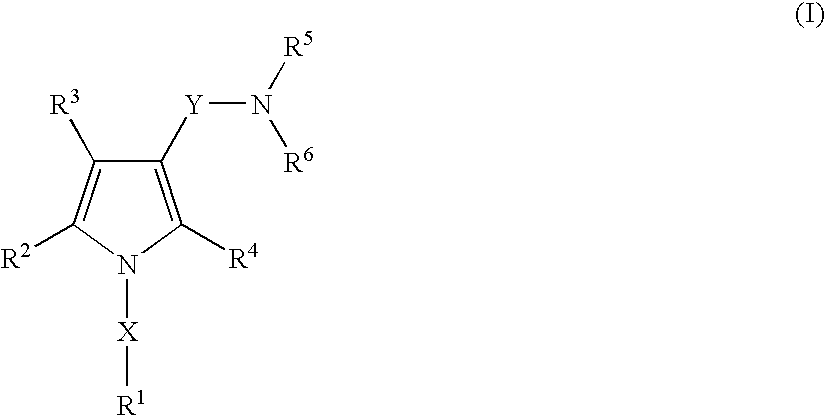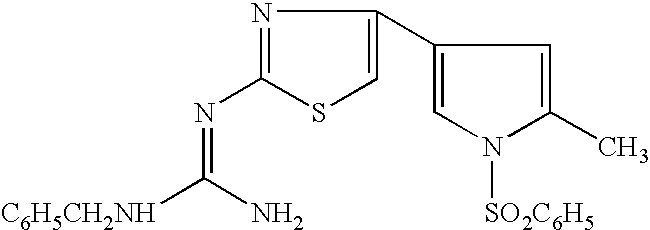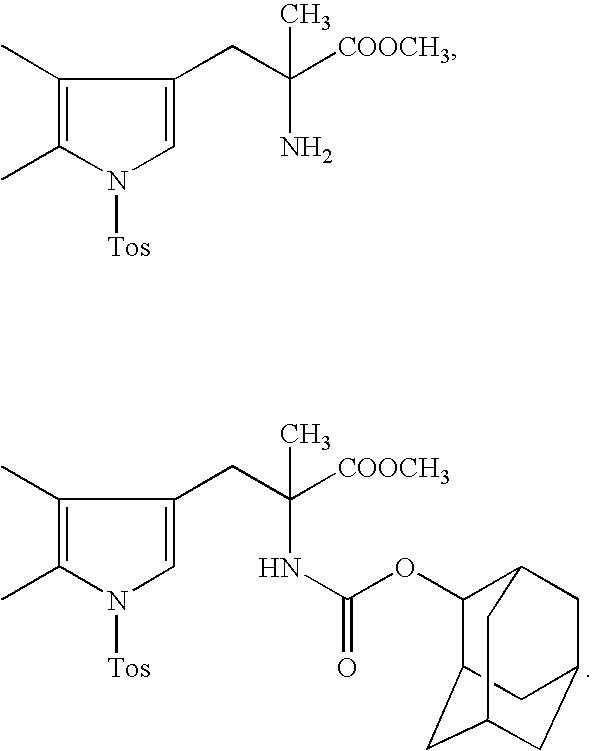Proton Pump Inhibitors
a proton pump inhibitor and pyrrole compound technology, applied in the direction of biocide, heterocyclic compound active ingredients, drug compositions, etc., can solve the problems that the proton pump inhibitor can not meet the requirements of proton pump inhibitors sufficiently, and the effect and side effects of proton pump inhibitors are associated with problems
- Summary
- Abstract
- Description
- Claims
- Application Information
AI Technical Summary
Benefits of technology
Problems solved by technology
Method used
Image
Examples
reference example 1
Ethyl 2-cyano-4-oxo-4-phenylbutanoate
[0330]Potassium carbonate (13.82 g) was added to ethyl cyanoacetate (37 mL), and the mixture was stirred at 40-45° C. for 45 min. A solution (100 mL) of phenacyl bromide (10.0 g) in acetone was added dropwise over 30 min. After completion of the dropwise addition, and the mixture was stirred at room temperature for 18 hr. The reaction mixture was filtered, and the filtrate was concentrated under reduced pressure. Water was added to the residue, and the mixture was extracted with ethyl acetate. The extract was washed with saturated brine, dried over anhydrous sodium sulfate, and concentrated under reduced pressure. Excess ethyl cyanoacetate contained in the obtained oil was evaporated under reduced pressure, and the residue was purified by silica gel column chromatography (eluent: hexane-ethyl acetate=8:1→1:1) to give the title compound as a pale-yellow oil (yield 10.41 g, 90%).
[0331]1H-NMR (CDCl3) δ: 1.35 (3H, t, J=7.2 Hz), 3.55 (1H, dd, J=16.0 H...
reference example 2
Ethyl 2-chloro-5-phenyl-1H-pyrrole-3-carboxylate
[0332]To a solution (60 mL) of ethyl 2-cyano-4-oxo-4-phenylbutanoate (5.0 g) in tetrahydrofuran was blown in hydrogen chloride (28 g) under ice-cooling, and the mixture was stirred at room temperature for 3 hr. Then, nitrogen was blown in to remove hydrogen chloride. The reaction mixture was concentrated under reduced pressure, and the residue was purified by silica gel column chromatography (eluent: hexane-ethyl acetate=6:1) to give the title compound as a pale-yellow solid (yield 4.24 g, 79%).
[0333]1H-NMR (CDCl3) δ: 1.37 (3H, t, J=6.8 Hz), 4.33 (2H, q, J=6.8 Hz), 6.87 (1H, d, J=3.2 Hz), 7.20-7.60 (5H, m), 8.79 (1H, br).
reference example 3
Ethyl 5-phenyl-1H-pyrrole-3-carboxylate
[0334]To a solution (50 mL) of ethyl 2-chloro-5-phenyl-1H-pyrrole-3-carboxylate (8.5 g) in ethanol was added 10% palladium carbon (50% water containing product, 0.5 g), and the mixture was stirred under a hydrogen atmosphere at room temperature for 24 hr. The reaction mixture was filtered, and the filtrate was concentrated under reduced pressure. The residue was purified by silica gel column chromatography (eluent: hexane-ethyl acetate=9:1→1:1) to give the title compound as a colorless solid (yield 4.50 g, 62%).
[0335]1H-NMR (CDCl3) δ: 1.36 (3H, t, J=7.2 Hz), 4.31 (2H, q, J=7.2 Hz), 6.91 (1H, m), 7.20-7.70 (6H, m), 8.77 (1H, br).
PUM
| Property | Measurement | Unit |
|---|---|---|
| temperature | aaaaa | aaaaa |
| temperature | aaaaa | aaaaa |
| temperature | aaaaa | aaaaa |
Abstract
Description
Claims
Application Information
 Login to View More
Login to View More - R&D
- Intellectual Property
- Life Sciences
- Materials
- Tech Scout
- Unparalleled Data Quality
- Higher Quality Content
- 60% Fewer Hallucinations
Browse by: Latest US Patents, China's latest patents, Technical Efficacy Thesaurus, Application Domain, Technology Topic, Popular Technical Reports.
© 2025 PatSnap. All rights reserved.Legal|Privacy policy|Modern Slavery Act Transparency Statement|Sitemap|About US| Contact US: help@patsnap.com



